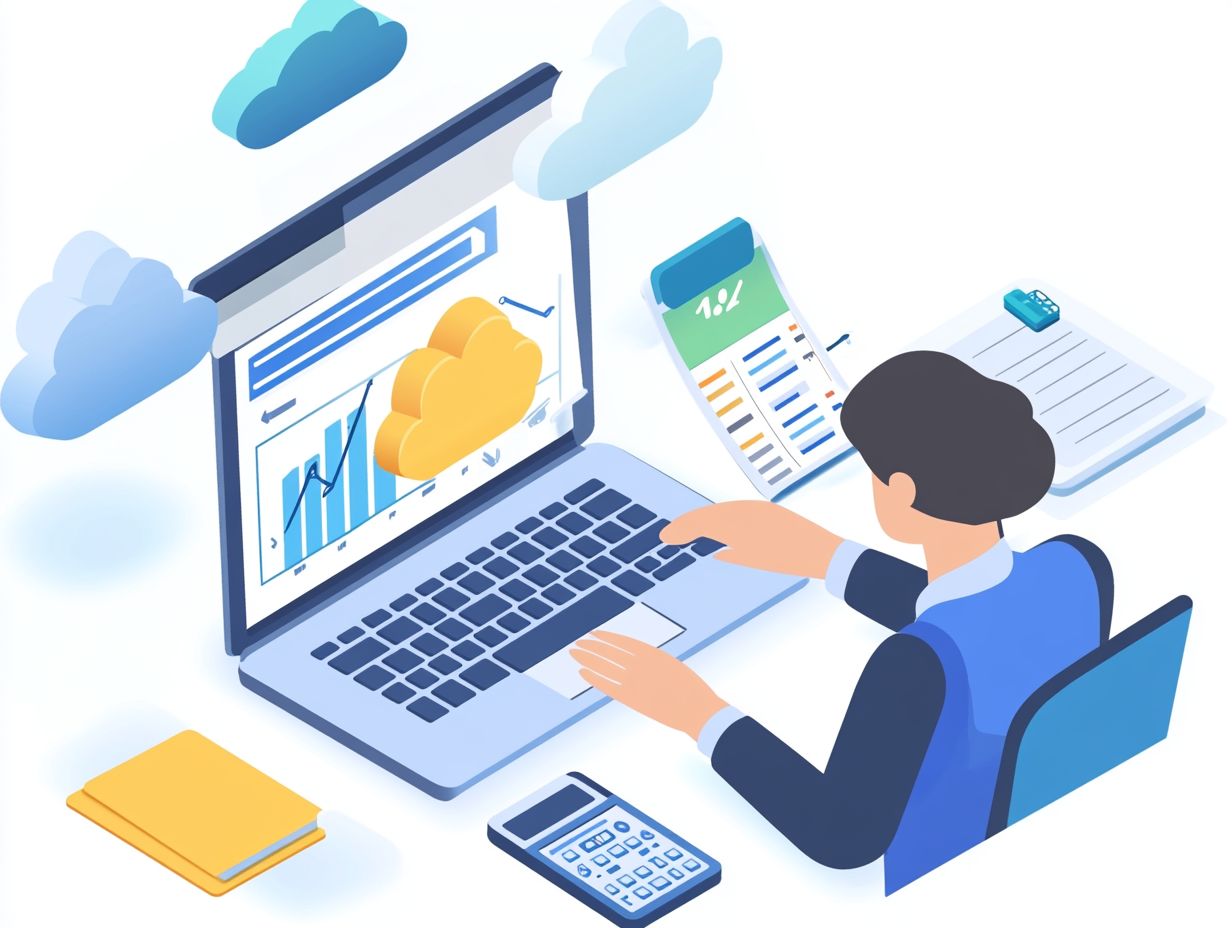Navigating Cloud Pricing Structures
Cloud computing has transformed how businesses operate, yet navigating its pricing structures can often seem daunting.
This article demystifies the various pricing models at your disposal, shedding light on the crucial factors that impact costs.
You’ll discover a side-by-side comparison of top cloud providers, helping you make the best choice! You’ll also find practical tips to optimize your cloud spending.
The article also explores new trends in cloud pricing, equipping you to remain proactive in this swiftly evolving landscape.
Prepare to take command of your cloud costs!
Contents
- Key Takeaways:
- Understanding Cloud Pricing Structures
- Factors Affecting Cloud Pricing
- Comparing Cloud Providers
- Tips for Navigating Cloud Pricing
- Future of Cloud Pricing
- Preguntas Frecuentes
- C mo puedo entender y comparar diferentes estructuras de precios para servicios en la nube?
- Cu les son los beneficios de un modelo de precios de pago por uso?
- C mo funciona el precio de las instancias reservadas?
- Qu es el precio de spot y cu ndo deber a considerar utilizarlo?
- Existen costos ocultos en las estructuras de precios en la nube?
- C mo puedo optimizar mis gastos en la nube?
Key Takeaways:

Understand the different pricing models available in the cloud, such as pay-per-use, subscription, and reserved instances, including usage-based pricing, to choose the best fit for your business needs.
Consider factors such as storage, data transfer, and support when evaluating cloud pricing to avoid unexpected costs and optimize for your usage patterns.
Compare cost analysis across popular cloud providers to find the most cost-effective option for your specific workloads and usage patterns.
Understanding Cloud Pricing Structures
Understanding cloud storage pricing models is vital if you’re aiming to optimize your budget and enhance financial flexibility in cloud computing.
Numerous pricing models exist, including pay-as-you-go, which means you only pay for what you use, subscription-based, reserved instances, and spot pricing.
Each model presents unique advantages for your enterprise as you harness cloud services effectively.
With the rise of cloud adoption among both startups and established corporations, grasping these models can significantly influence your ability to manage costs.
It helps you align cloud resources with your specific workload requirements.
Overview of Different Pricing Models
Cloud pricing models present a variety of approaches that grant you different levels of flexibility and cost management for cloud services.
You ll encounter options like pay-as-you-go, subscription-based, reserved instances, and the spot pricing model.
Each of these models is designed to cater to distinct usage patterns and financial strategies, making it crucial for you to assess your specific needs.
If you re a business that thrives on scalability without the burden of long-term commitments, the pay-as-you-go model might just be your best friend.
On the other hand, if you prefer predictable expenses, subscription-based pricing could be right up your alley.
Reserved instances, where you commit to use a specific amount of resources for a set time in exchange for lower rates, are an appealing choice for companies with stable workloads.
The spot pricing model can provide significant cost reductions but comes with the caveat of potentially interrupted service, making it ideal for those with more flexible workloads.
By understanding these nuances, you can better align your cloud spending with your operational demands and budgetary constraints.
Factors Affecting Cloud Pricing
Numerous factors play a pivotal role in shaping cloud pricing, impacting how you can effectively harness cloud services while ensuring a cost-effective approach to resource allocation.
By grasping the intricacies of variables like workload patterns, cloud capacity, and the specific service categories provided by various cloud providers, you’ll make well-informed decisions regarding financial commitments.
These insights are essential for any organization striving to navigate market competition while maintaining budget predictability.
Start exploring these models today and take control of your cloud expenses!
Key Considerations for Pricing

When evaluating cloud pricing, several key considerations should be at the forefront of your analysis. This ensures you achieve cost-effective solutions while maintaining financial flexibility in the face of unpredictable workloads and volatile pricing models.
This evaluation process should encompass a thorough analysis of service performance metrics. These metrics directly influence your efficiency and productivity.
It s essential to look beyond just the initial costs and consider the long-term potential savings realized through optimized usage and scalability.
Utilizing pricing calculators can offer invaluable insights. They allow you to simulate various scenarios and predict expenses with greater accuracy.
Understanding different pricing structures, such as pay-as-you-go versus reserved instances, is equally vital for understanding hybrid cloud cost structures.
Ultimately, adopting a well-rounded approach empowers you to make informed decisions tailored to your unique operational demands.
Comparing Cloud Providers
Comparing cloud providers like Amazon EC2, Azure, and Google Cloud Platform is vital. It helps you optimize resources and find the best pricing for your needs.
The diversity in offerings and pricing structures among these platforms can be quite striking. Each provider brings unique pricing models, performance metrics, and scalability options to the table, all of which can significantly influence your overall operational costs and user engagement.
Cost Analysis for Popular Providers
Conducting a cost analysis for leading cloud providers like Amazon EC2, Azure, and Google Cloud Platform gives you the power to grasp the financial implications of adopting their services. This insight is invaluable for making informed decisions based on precise pricing calculations and your operational requirements.
By diving into various pricing models, such as options where you pay only for what you use without managing servers, you can uncover the most cost-effective solutions tailored to your specific workloads.
A meticulous examination of different instance types reveals how each provider allocates resources, which directly impacts your overall expenses.
Factors such as persistent storage costs, data transfer fees, and potential discounts can significantly sway your total expenditures.
This comparative analysis allows you to align your cloud strategies with budget constraints while optimizing performance and scalability. Ensure you choose a provider that fulfills both your financial and operational aspirations.
Navigating cloud pricing can feel like a labyrinth, but with the right strategies for cost optimization, you can significantly enhance your cloud budget by understanding cloud billing models and improve the efficiency of your resource allocation.
Get excited about optimizing your cloud budget by exploring various pricing models! By leveraging tools such as pricing calculators, you can strategically manage your cloud utilization and align it with your workload requirements.
This approach maximizes your investment and ensures your resources are allocated in the most effective manner.
Strategies for Cost Optimization

Strategies for cost optimization in cloud computing are crucial for maximizing your cloud efficiency and ensuring effective resource allocation within your budget.
Monitoring usage is key; it helps identify underused resources that can be downsized or eliminated altogether.
Analyzing workload requirements helps you understand peak usage times and patterns, enabling you to adjust resource allocation to better align with actual needs.
For instance, autoscaling can automatically adjust resources based on demand, which is essential for preventing over-provisioning.
Use tools that provide detailed insights into resource performance to make informed decisions. This ultimately leads to streamlined operations and reduced expenditure.
Start evaluating your cloud options today to unlock savings and boost your efficiency!
Future of Cloud Pricing
The future of cloud pricing is transforming, driven by new technology trends, increased market competition, and evolving cloud services that demand more transparency and flexibility in pricing.
As you explore a mix of different cloud services and utilize advanced data analytics, understanding these trends will be crucial for optimizing costs and improving your cloud investments.
Predictions and Trends
Predictions in cloud pricing indicate a shift towards flexible and scalable pricing models designed to meet the diverse needs of your business as it manages varying workloads.
This change is primarily driven by the rise of options where you pay only for the computing power when you actually use it. This approach reduces waste and significantly boosts cost efficiency.
As you increasingly adopt a mix of cloud strategies to optimize performance while controlling expenses, the need for advanced resource optimization tools becomes vital.
Emerging technologies like AI and machine learning are opening doors for predictive analytics that help you anticipate usage patterns and adjust your spending accordingly.
Together, these trends show that the cloud pricing landscape is becoming more user-friendly, encouraging you to rethink and refine your cloud spending strategies.
Preguntas Frecuentes
C mo puedo entender y comparar diferentes estructuras de precios para servicios en la nube?

Para navegar por las estructuras de precios en la nube, primero es importante conocer los diferentes modelos de precios comunes. Estos incluyen pago por uso, instancias reservadas y precios de spot.
Una vez que comprendas lo b sico de estos modelos, podr s comparar los costos y caracter sticas de diferentes proveedores para encontrar la mejor opci n para tus necesidades.
Cu les son los beneficios de un modelo de precios de pago por uso?
El modelo de precios de pago por uso te permite pagar solo por los recursos que realmente utilizas, lo que lo hace rentable para empresas con necesidades cambiantes.
Adem s, puedes escalar tu uso f cilmente, lo cual es un gran avance para tu negocio.
C mo funciona el precio de las instancias reservadas?
El precio de las instancias reservadas implica comprometerse a usar recursos espec ficos durante un per odo determinado, t picamente uno o tres a os.
Esta opci n suele ofrecer tarifas con descuento en comparaci n con el pago por uso, lo que la hace atractiva para cargas de trabajo predecibles. Sin embargo, viene con un contrato y puede no ser tan flexible como el pago por uso.
Qu es el precio de spot y cu ndo deber a considerar utilizarlo?
El precio de spot implica pujar por recursos en la nube no utilizados a un precio reducido. Esto puede ser una opci n rentable para empresas con cargas de trabajo no cr ticas o aquellas dispuestas a asumir algo de riesgo.
Es vital recordar que las instancias de spot pueden ser terminadas en cualquier momento si el precio del mercado aumenta o si los recursos son requeridos por otro usuario.
Existen costos ocultos en las estructuras de precios en la nube?
Aunque los proveedores pueden publicitar tarifas base bajas, pueden existir costos adicionales por caracter sticas o servicios espec ficos.
Por ejemplo, puede haber cargos por transferencias de datos, almacenamiento, o soporte adicional. Es fundamental revisar cuidadosamente los detalles de precios y hacer preguntas para comprender todos los costos potenciales.
C mo puedo optimizar mis gastos en la nube?
Para optimizar tus gastos en la nube, revisa regularmente tu uso y ajusta seg n sea necesario.
Esto puede incluir el uso de herramientas de gesti n de costos proporcionadas por el proveedor, monitorear tu uso de cerca e implementar medidas de ahorro, como apagar recursos no esenciales cuando no est n en uso.
Tambi n es til reevaluar peri dicamente tus necesidades y considerar si un modelo de precios o proveedor diferente se adapta mejor a tu presupuesto y patrones de uso.





